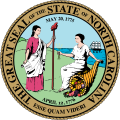| President pro tempore of the North Carolina Senate | |
|---|---|
 | |
| North Carolina Senate | |
| Status | Presiding officer |
| Seat | North Carolina State Legislative Building, Raleigh, North Carolina |
| Nominator | Major parties (normally) |
| Appointer | The North Carolina Senate |
| Term length | two years (currently) |
| Constituting instrument | North Carolina Constitution |
| Formation | 1777 |
| First holder | Samuel Ashe |
| Succession | Second |
The president pro tempore of the North Carolina Senate (more commonly, "Pro-Tem") is the highest-ranking (internally elected) officer of one house of the North Carolina General Assembly. The president of the Senate is the Lieutenant Governor of North Carolina, but the president pro tempore actually holds most of the power and presides in the absence of the Lt. Governor. The president pro tempore, a senior member of the party with a majority of seats, appoints senators to committees and also appoints certain members of state boards and commissions. From 1777 to 1868, North Carolina had no Lieutenant Governor, and the highest-ranking officer of the Senate was known as the "Speaker". The Speaker of the Senate was next in line if the office of Governor became vacant. This occurred on two occasions.
Contents
- History
- Powers and duties
- North Carolina Senate presiding officers
- Speakers
- Presidents pro tempore
- See also
- References
- Works cited
Presidents pro tempore are elected at the beginning of each biennial session, currently in January of odd-numbered years. Between 1868 and 1992, it was rare for a president pro tempore to serve more than two terms. Marc Basnight, however, became arguably the most powerful North Carolina Senate leader in history and one of the state's most influential politicians when he served a record nearly 18 years as president pro tempore.




